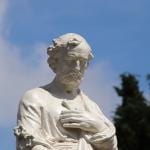What is Protestantism? This is a question that seems easy to answer on the surface, but becomes more complex as one looks deeper. Protestantism is ever adapting and boasts over 34,000 Christian groups with more coming into existence almost daily[1]. The radical idea that protestant was founded upon was the priesthood of believers, and the belief that people should read the Bible for themselves without the central authority of a church (though there is much more nuance than that in reality)[2]. It is around this idea that Dr. Alister McGrath titles his work Christianity’s Dangerous Idea. Dr. McGrath is very accomplished as he is the author of multiple books, Professor of Science and Religion at Oxford, and fellow of Harris Manchester College[3].
SUMMARY
The work is strategically divided into three parts: Origination, Manifestation, and Transformation. The section known as origination lays the foundations of the Protestant movement. Dr. McGrath discusses the corruption of the clergy, the abuse of the doctrine of indulgences, and the rise of humanists that laid the foundation for what would become known as the Protestant Reformation. As Dr. McGrath states, “This growing popular interest in religion led to a lay criticism of the institutional church where it was felt to be falling short of its obligations[4].” This paved the way for Martin Luther and his 95 theses against the Church of Rome. The theses and Justification by faith are discussed further in chapter two. The following two chapters reflect on Lutheranism and the rise of John Calvin. The rise of the Puritans and the start of the Anglican Church is then looked at in great detail. The English Civil War and Protestant persecution that took place over two centuries is outlined in chapter six. At this point Protestantism comes to America to seek religious liberty, and that migration is the topic of chapter 7. Chapter 7 also includes events such the Great Awakening and the role of Protestantism in the American Revolution. Section one comes to its conclusion with the onset of World War I, but not before the expansion of Protestantism because of an emphasis on missions. Dr. McGrath writes, “The great era of Protestant missions came to an end in 1914 with the outbreak of the Great War, as it was known then[5].”
Section Two starts out with the role of the Holy Bible in Protestantism. The Latin term Sola Scriptura, which means scripture alone, is one of the pillars that the movement was founded upon. However within Protestantism there are various ways that this term is interpreted, and subsequently there are various groups who interpret scripture differently. This leads into a discussion of various Protestant belief, liberal versus conservative, church government, and the like. Denominational structures, music, and preaching styles are discussed in chapter 11. Chapter 11 is concluded with a poignant question. Dr. McGrath asks, “But what of the society within which Protestantism is located? In what ways do its beliefs and values influence culture in general[6]?” These are still questions that must be asked today.
Section three started out with a revival on Azusa Street in Los Angeles, California. This revival has people speaking in tongues and would come to be known as the birth of Pentecostalism[7]. Chapter 14 further explores denominations, and the view on Catholicism. Chapter 16 delves into the Global south and how Protestantism is a dominant force there. The global south tends to be more Pentecostal in nature, and denominations “have more in common with each other than with their counterparts in America or Europe[8].” The section concludes with discussions on the roles of denominational authority, the change in Biblical interpretation, and the future role of Protestantism. Dr. McGrath ends with a very interesting statement as he states, “The future of Protestantism lies precisely in Protestantism being what Protestantism actually is[9].”
CRITICAL INTERACTION OF CHRISTIANITY’S DANGERUS IDEA
On page 8 of the work Dr. McGrath lays out the reasons on why his study is needed. He does it in a very methodical and sensible way. Reason one for the study is that of scholarship. Recent scholarship has moved away from the social reasons why the reformation took place, and emphasize the religious aspects[10]. Secondly it is not right to determine the state of the medieval church through the eyes of its opponents such as Luther and Calvin[11]. Thirdly is an issue of a theological nature, because the terms “Protestantism” and “Reformation” can no longer be used synonymously though this used to be the case[12]. A fourth reason for the study is because previous studies have been influenced by Protestant leaders and ideas[13]. Lastly Protestantism itself has changed so a new study is essential[14].
These five reasons for the study open the reader up to a history that may be known generally, but is broken down into specifics. Dr. McGrath describes how a Christian that reads the Bible for himself is dangerous. He is dangerous because there are different interpretations, and this did and still does cause much debate. To drive his point home Dr. McGrath makes heavy use of historical records that the average layman may have never heard of. However these resources are enlightening to say the least. Dr. McGrath also points out the socioeconomic conditions that made the world so ripe for Protestantism. Underneath the historical evidence is an evolution of a movement that has been able to make itself available to the masses. As an example Dr. McGrath begins with Martin Luther nailing his 95 Theses to the church door to Azusa Street Revival and the birth of Pentecostalism. He proves through history that Protestantism has been able to adapt to meet the needs of the people.
As great as the book is there are some challenge. In regards to this John Battle of Western Reformed Seminary writes, “he often fails to distinguish what I would consider to be orthodox from heterodox ideas. He includes all parts of the spectrum—liberal and conservative—as Protestantism, and treats all as equally authentic versions[15].” Mr. Battle brings up a good point in this regard. There are some liberal denominations where Sola Scriptura hardly applies to some of their social stances. If their social stance contradicts the Bible can they be regarded as a denomination within Protestantism? However Dr. McGrath is writing is broad terms and is not out to label a denomination as right or wrong. The book is wide and covers a lot of ground in this regard. It is about the history, growth, and future of Protestantism. Rev. Rollin Shoemaker endorses the book as history of the reformation. In his review Rev. Shoemaker states, “I think every pastor should read this book because it refreshes one’s memory of what happened in the Reformation as well as how Protestantism developed into what it is today[16].” The outcome of the work is simple. Protestantism still has life, will continue to grow, and will continue to adapt. It will remain a force in the world and it is important to understand its history.

CONCLUSION
Dr. McGrath has written a very influential book on the history of Protestantism. It takes a different look at the reformation because it looks at the whole picture, not just the theology behind it. Those looking for a theological study of the reformation will be hard pressed to find it here. This book is strictly about the historical aspects, though some theological aspects are touched they are not expanded upon. The idea of individual interpretation of scripture continues to evolve, and has become a dangerous proposition in some cases. Protestantism will march on into the future, but there are issues that must be addressed. This book is a refreshing read on the history of Protestantism and is recommended to review.
Bibliography
“Alister McGrath,” Oxford University, accessed April 10, 2015, http://users.ox.ac.uk/~mcgrath/.
“Book Review: Christianity’s Dangerous Idea: The Protestant Revolution—a History From The Sixteenth Century To The Twenty-first,” Ministry Magazine, accessed April 18, 2015 September 1, 2012, https://www.ministrymagazine.org/archive/2012/09/christianity%E2%80%99s-dangerous-idea.
“Review of McGrath, “Christianity’s Dangerous Idea”,” Western Reformed Seminary, accessed April 18, 2015, http://www.wrs.edu/review-of-mcgrath-christianitys-dangerous-idea/.
Barrett, David B… World Christian Encyclopedia, 2nd ed., s.v. “Christian Denominations.”
McGrath, Alister. Christianity’s Dangerous Idea. New York, NY: Harperone, 2007.
[1] David B. Barrett, World Christian Encyclopedia, 2nd ed., s.v. “Christian Denominations.”
[2] Alister McGrath, Christianity’s Dangerous Idea (New York, NY: Harperone, 2007), 3.
[3] “Alister McGrath,” Oxford University, accessed April 10, 2015, http://users.ox.ac.uk/~mcgrath/.
[4] Alister McGrath, Christianity’s Dangerous Idea (New York, NY: Harperone, 2007), 24.
[5] Ibid, 196.
[6] Alister McGrath, Christianity’s Dangerous Idea (New York, NY: Harperone, 2007), 310.
[7] Ibid, 389.
[8] Ibid, 440.
[9] Ibid, 478.
[10] Alister McGrath, Christianity’s Dangerous Idea (New York, NY: Harperone, 2007), 8.
[11] Ibid, 8.
[12] Ibid, 9.
[13] Ibid, 9.
[14] Ibid, 9.
[15] “Review of McGrath, “Christianity’s Dangerous Idea”,” Western Reformed Seminary, accessed April 18, 2015, http://www.wrs.edu/review-of-mcgrath-christianitys-dangerous-idea/.
[16] “Book Review: Christianity’s Dangerous Idea: The Protestant Revolution—a History From The Sixteenth Century To The Twenty-first,” Ministry Magazine, accessed April 18, 2015 September 1, 2012, https://www.ministrymagazine.org/archive/2012/09/christianity%E2%80%99s-dangerous-idea.













